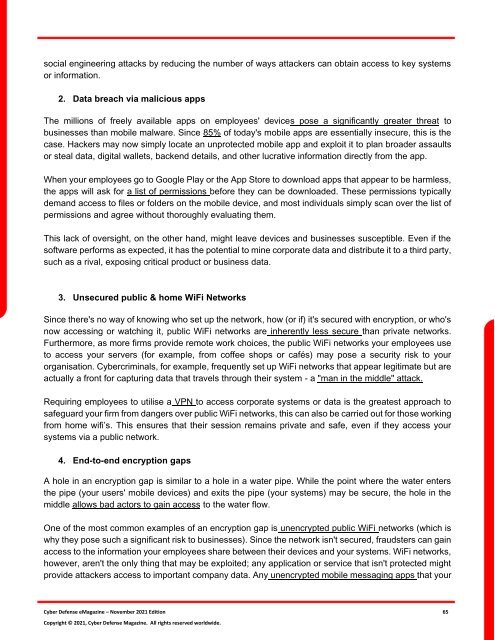Cyber Defense eMagazine November Edition for 2021
Cyber Defense eMagazine November Edition for 2021 #CDM #CYBERDEFENSEMAG @CyberDefenseMag by @Miliefsky a world-renowned cyber security expert and the Publisher of Cyber Defense Magazine as part of the Cyber Defense Media Group as well as Yan Ross, US Editor-in-Chief, Pieruligi Paganini, International Editor-in-Chief and many more writers, partners and supporters who make this an awesome publication! Thank you all and to our readers! OSINT ROCKS! #CDM #CDMG #OSINT #CYBERSECURITY #INFOSEC #BEST #PRACTICES #TIPS #TECHNIQUES See you at RSA Conference 2022 - Our 10th Year Anniversary - Our 10th Year @RSAC #RSACONFERENCE #USA - Thank you so much!!! - Team CDMG
Cyber Defense eMagazine November Edition for 2021 #CDM #CYBERDEFENSEMAG @CyberDefenseMag by @Miliefsky a world-renowned cyber security expert and the Publisher of Cyber Defense Magazine as part of the Cyber Defense Media Group as well as Yan Ross, US Editor-in-Chief, Pieruligi Paganini, International Editor-in-Chief and many more writers, partners and supporters who make this an awesome publication! Thank you all and to our readers! OSINT ROCKS! #CDM #CDMG #OSINT #CYBERSECURITY #INFOSEC #BEST #PRACTICES #TIPS #TECHNIQUES
See you at RSA Conference 2022 - Our 10th Year Anniversary - Our 10th Year @RSAC #RSACONFERENCE #USA - Thank you so much!!! - Team CDMG
Create successful ePaper yourself
Turn your PDF publications into a flip-book with our unique Google optimized e-Paper software.
social engineering attacks by reducing the number of ways attackers can obtain access to key systems<br />
or in<strong>for</strong>mation.<br />
2. Data breach via malicious apps<br />
The millions of freely available apps on employees' devices pose a significantly greater threat to<br />
businesses than mobile malware. Since 85% of today's mobile apps are essentially insecure, this is the<br />
case. Hackers may now simply locate an unprotected mobile app and exploit it to plan broader assaults<br />
or steal data, digital wallets, backend details, and other lucrative in<strong>for</strong>mation directly from the app.<br />
When your employees go to Google Play or the App Store to download apps that appear to be harmless,<br />
the apps will ask <strong>for</strong> a list of permissions be<strong>for</strong>e they can be downloaded. These permissions typically<br />
demand access to files or folders on the mobile device, and most individuals simply scan over the list of<br />
permissions and agree without thoroughly evaluating them.<br />
This lack of oversight, on the other hand, might leave devices and businesses susceptible. Even if the<br />
software per<strong>for</strong>ms as expected, it has the potential to mine corporate data and distribute it to a third party,<br />
such as a rival, exposing critical product or business data.<br />
3. Unsecured public & home WiFi Networks<br />
Since there's no way of knowing who set up the network, how (or if) it's secured with encryption, or who's<br />
now accessing or watching it, public WiFi networks are inherently less secure than private networks.<br />
Furthermore, as more firms provide remote work choices, the public WiFi networks your employees use<br />
to access your servers (<strong>for</strong> example, from coffee shops or cafés) may pose a security risk to your<br />
organisation. <strong>Cyber</strong>criminals, <strong>for</strong> example, frequently set up WiFi networks that appear legitimate but are<br />
actually a front <strong>for</strong> capturing data that travels through their system - a "man in the middle" attack.<br />
Requiring employees to utilise a VPN to access corporate systems or data is the greatest approach to<br />
safeguard your firm from dangers over public WiFi networks, this can also be carried out <strong>for</strong> those working<br />
from home wifi’s. This ensures that their session remains private and safe, even if they access your<br />
systems via a public network.<br />
4. End-to-end encryption gaps<br />
A hole in an encryption gap is similar to a hole in a water pipe. While the point where the water enters<br />
the pipe (your users' mobile devices) and exits the pipe (your systems) may be secure, the hole in the<br />
middle allows bad actors to gain access to the water flow.<br />
One of the most common examples of an encryption gap is unencrypted public WiFi networks (which is<br />
why they pose such a significant risk to businesses). Since the network isn't secured, fraudsters can gain<br />
access to the in<strong>for</strong>mation your employees share between their devices and your systems. WiFi networks,<br />
however, aren't the only thing that may be exploited; any application or service that isn't protected might<br />
provide attackers access to important company data. Any unencrypted mobile messaging apps that your<br />
<strong>Cyber</strong> <strong>Defense</strong> <strong>eMagazine</strong> – <strong>November</strong> <strong>2021</strong> <strong>Edition</strong> 65<br />
Copyright © <strong>2021</strong>, <strong>Cyber</strong> <strong>Defense</strong> Magazine. All rights reserved worldwide.


















